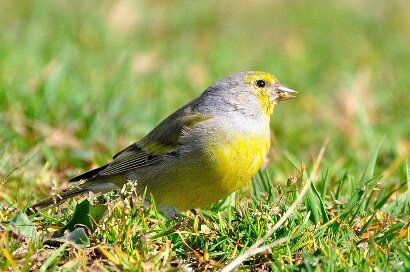Citril Finch
Carduelis citrinella (Pallas, 1764)
Photo © By Sandra from France - Plateau de beilleUploaded by snowmanradio, CC BY 2.0, https://commons.wikimedia.org/w/index.php?curid=24721680
STATUS
Eurasia. Monotypic.
OVERVIEW
BOU (1971) accepted one record from Norfolk in 1904, however, this was reidentified as a Cape Canary Serinus canicollis.
NOT PROVEN
0). 1869 Sussex Near Brighton, male, caught, 20th November.
(F. Bond, Zoologist 1869: 1984).
[F. Bond, Zoologist 1870: 2022; BOU, 1883].
History Frederick Bond of South Hampstead, London (1869) in The Zoologist, 2nd series, Vol. IV. p. 1984, dated 15th December, 1869, says: 'A fine male was captured on the 20th of November. This is, I believe, only the second specimen that has been taken in this country: the first one in the rich collection of Mr. Monk, of Lewes.'
Frederick Bond (1870) in The Zoologist, 2nd series, Vol. V. p. 2022, says: 'The Citril Finch mentioned in the same communication must also be struck out of my list. I regret very much that I have made such a mistake: the two birds are most certainly wild canaries. By the kindness of my friend Mr. J. J. Weir, who took the trouble of comparing skins of the wild Canary with Mr. Monk's first bird, I now possess the skins he used for the comparison in my collection, and I find that the skin of the wild bird is identical with the specimen captured in November last, and the skin of the female bird, Mr. Weir tells me, is identical with Mr. Monk's first bird. I will be more careful next time, and will not trust to memory.'
Not admitted nationally in their first List of British Birds (BOU (1883: 47).
Comment Misidentified. Not acceptable.
0). 1886 Sussex Brighton, caught, 14th October.
(H. Langton, Zoologist 1886: 491).
[J. E. Harting, Zoologist 1887: 72-73; Zoologist 1888: 108; Harting, 1901; Not in BOU, 1971].
History Herbert Langton of Brighton (1886) in The Zoologist, 3rd series, Vol. X. p. 491, says: '...On October 14th a Citril Finch was caught near the race-course. This bird is still alive, in the possession of Mr. Swaysland, Upper Russell Street, Brighton.'
J. E. Harting, Editor (1887) in The Zoologist, 3rd series, Vol. XI. pp. 72-73, says: 'In The Zoologist for December last (p. 490), Mr. Herbert Langton reported the capture of the Citril Finch, Fringilla citrinella, near the race-course at Brighton on the previous 14th October. A little correspondence on the subject has resulted in Mr. Swaysland of Brighton bringing the bird to London for inspection; and on submitting it to Mr. Sharpe, of the Natural History Museum, South Kensington, who has paid a good deal of attention to Finches, he pronounced it to be not the Citril Finch, but the Cape Canary, Serinus canicollis. At first glance the two species are not very unlike, and might be easily confounded in the absence of specimens for comparison. In fact, both these birds, as well as the wild Canary, Serinus canaria, or the Serin, Serinus hortulanus, have such a general resemblance in size and colour that it requires a practised eye to discriminate them offhand.'
Not admitted nationally (BOU 1971).
Comment Misidentified. Swaysland has been discredited (A. H. J. Harrop, British Birds 112: 89-98). Not acceptable.
0). 1888 Norfolk North Denes, Great Yarmouth, obtained, 31st June, now at Birmingham Museums and Art Gallery (Acc. No. 1924Z18.3621).
(Watson, 2010).
[BOU, 1971].
History Watson (2010) in detailing the R. W. Chase collection in the Birmingham Museum lists this specimen and quoting from his Notebooks adds G. Smith with no further information.
Comment 31st June!!! George Smith was a dealer of ill repute.
0). 1904 Norfolk Near Great Yarmouth, caught, 29th January, now at Booth Museum, Brighton.
(J. H. Gurney, jun., Zoologist 1905: 91; H. Saunders, British Birds 1: 12; P. G. R. Barbier, British Birds 61: 92-93; A. G. Knox, British Birds 87: 471; R. J. Fairbank, British Birds 88: 244-245; Seago, 1977; Allard, 1990; W. R. P. Bourne, British Birds 89: 189-190).
[A. G. Knox, British Birds 87: 471-473; BOURC (1994), Ibis 136: 497; P. R. Allard, Norfolk Bird & Mammal Report 1994: 366-367].
History J. H. Gurney, jun., of Keswick Hall, Norwich (1905) in The Zoologist, 4th series, Vol. IX, p. 91, says: 'January 29th. S.W., 3. A Citril Finch, Chrysomitris citrinella (L.) - an adult female in good feather - taken with an ordinary call-bird by J. Quinton, one of our Yarmouth birdcatchers, who generally plies his trade on the denes. I am indebted to Mr. E. C. Saunders for a knowledge of this rarity, which is now in his possession. It is just possible it may be an escaped one, but it must be remembered how many migrants follow the eastern coast-line. The Citril Finch is stated to be fairly common in Baden, which is only three hundred miles away, a distance a bird may easily cover in a strong gale of wind such as blew on the 27th from S.S.W.'
Patterson (1905) says: 'Netted in the Yarmouth area by a bird-catcher named Quinton on 29th January 1904.'
Howard Saunders (1907) in British Birds, Vol. I. p. 12, under 'Additions to the List of British Birds since 1899,' says: 'In the Zoologist, 1905, p. 91, Mr. J. H. Gurney recorded the capture, on 29th January, 1904, of "an adult female in good feather", by a Yarmouth bird-catcher. It is rather surprising that this species has not been sooner recognized as an occasional visitor, for it is common - though local in the breeding-season - in Switzerland, Baden, and the mountains and hill-country of Central Germany; while it has occurred as a wanderer in Heligoland.'
Comment Misidentified. Correctly identified as a Cape Canary. Not acceptable.
